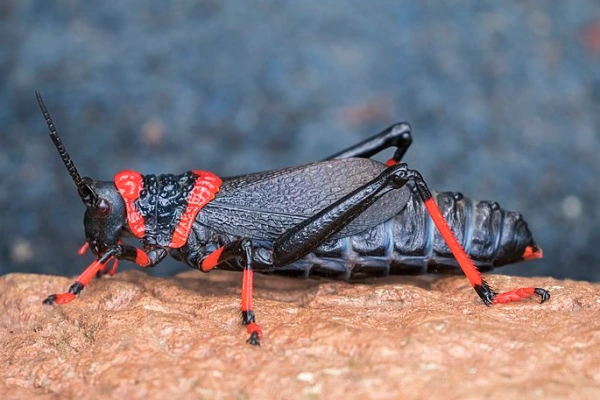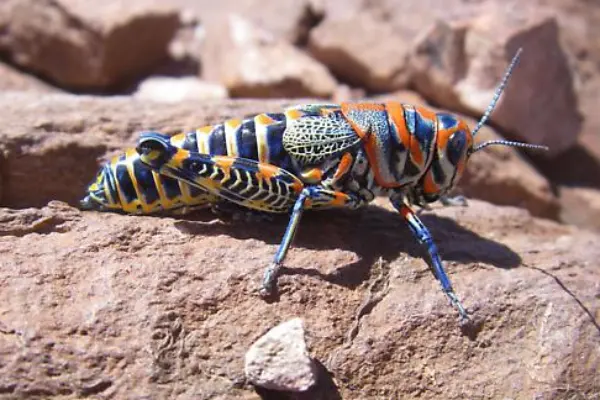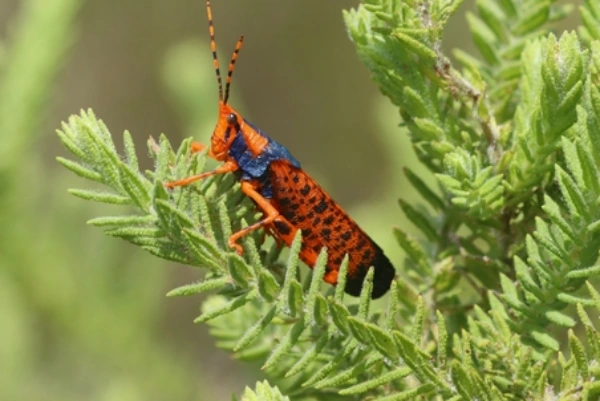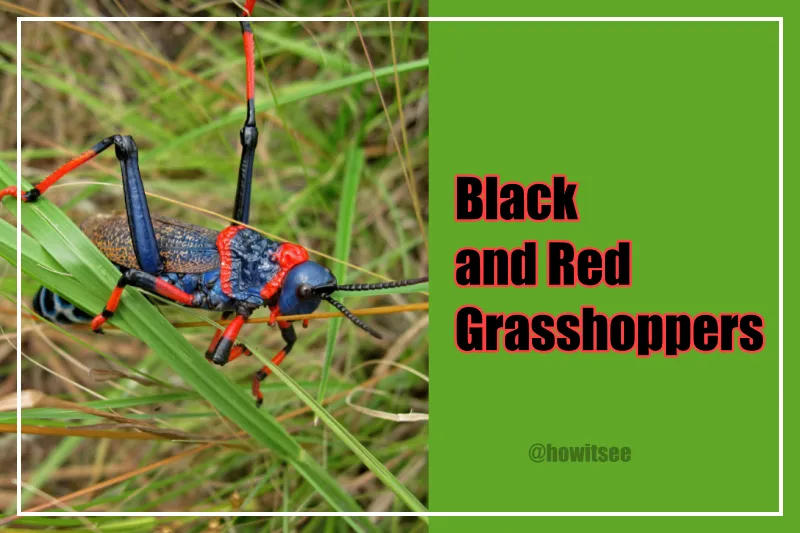Grasshoppers are the most familiar insects that are often seen as pests, but these jumping insects are more than just that. In previous articles, we got to know about the different colors of grasshoppers.
Have you ever thought about what other colors they occur in? Have you ever heard of black and red grasshoppers? They may sound feisty, but they are not like what their coloration shows. In this article, we’re going to look at these 10 black and red grasshoppers.
10 Black and Red Grasshoppers
1. Koppie foam grasshopper

| Scientific name | Dictyophorus spumans |
| Size | 3.1 inches |
| Location | South Africa |
| Identification | Large warty red neck shield |
This indigenous species of Africa is well known for its extraordinary black and red coloration. This flightless grasshopper is capable of reaching up to 80mm in length.
If they are afraid of being attacked, they release toxic foam from their thoracic gland, which is derived from milkweed.
Their blood contains cardiac glycosides, which are heart-stopping toxins. In the savannahs, grasslands, and forests, this solitary grasshopper can be seen.
2. Rainbow grasshopper

| Scientific name | Dactylotum bicolor |
| Size | 20-35 mm |
| Location | US, Canada, Northern Mexico |
| Identification | Mainly black with reddish markings |
This grasshopper is famous for its unique color pattern, which comprises reddish orange, yellow, white, and black markings, as depicted by its name.
These grasshoppers’ impressive colors trick predators into thinking they are deadly by deceiving them into believing that they are not Males tend to be smaller than females. Following Dichroplus silveiraguidoi, they had the least known number of chromosomes in grasshoppers.
3. Leichhardt’s grasshopper

| Scientific name | Petarida ephippigera |
| Size | 1-1.5 inches |
| Location | Kakadu national park, Arnhem land, Nitmiluk national park |
| Identification | Orangish red with significant black and blue patches |
This endemic species of Northern Australia is named after explorer Ludwig Leichhardt. The bodies of these creatures are red orangish, with black markings on them. The size of adults is significant, with average adult sizes reaching up to 2-3 inches.
Pityrodia bush is the only thing they eat, and that’s what makes them picky eaters. They are known for their unique chemical defense. They are the important part of kakadu ecosystem.
4. Mexican grasshopper
| Scientific name | Liladownsia fraile |
| Size | 1 inch |
| Location | Oaxaca, Mexico |
| Identification | Resembles fiery rainbow with red, yellow and black markings |
This grasshopper species was recently discovered on the side of a mountain road near Oaxaca, Mexico. They are small and have red, blue, yellow, and black markings that resemble a fiery rainbow, measuring up to 1 inch in size.
Their scientific name liladownsia fraile is dedicated to Grammy Award winning singer and Mexican musician ‘Lila Downs‘.
5. Red Milkweed grasshopper
| Scientific name | Phymateus morbillosus |
| Size | 70mm |
| Location | Southern, central and East Africa |
| Identification | Bright red head and legs and black marked forewings |
Phymateus morbillosus are cyclical migrants, which means they undergo a period of mass migration. Adults have a distinctive black and red colouration and are approximately 70 mm in body size.
Although their wings are fully developed, the females are unable to fly. They are famous for traveling long distances while migrating.
6. Giant red winged grasshopper
| Scientific name | Tropidacris cristata |
| Size | 10 cm |
| Location | South America (Trinidad) |
| Identification | have red body with black markings |
This is one of the largest insects in the world. They can be as large as 6.3 inches. During flight, they are often confused with birds due to their large size, making them often mistaken as birds.
They have marvellous red wings and black markings. A male’s behavior is to stridulate to attract females for mating. This herbivorous species feeds on a variety of plants inhabiting tropical rainforests.
7. Red thighed grasshopper
| Scientific name | Traulia |
| Size | 1.5 – 2 inches |
| Location | North America, Europe, Asia |
| Identification | Have black and yellow stripes all over the body and red hind tibia |
This species of pest of crops such as corn and soya beans are known to produce rattling sounds by their hindquarters. They are characterized by black – yellow stripes on the back and red hind limbs.
Male have an enlarged abdomen with U shaped sub genital plate. Their red hind limbs are the warning signs for the predators.
8. Red winged grasshopper
| Scientific name | Arphia pseudonietana |
| Size | 51mm |
| Location | North America |
| Identification | Black body with bright red wings |
The blood-red hindwings with prominent black rim is the characteristic of the red winged grasshopper. It is quite common in many places like Columbia, Ontario and Mexico.
The rattling sound of red winged grasshoppers is one of the characteristic sound of late summer in Grasslands. This species is called pseudonietana as it was first thought to be related to Mexican grasshopper.
9. African bush grasshopper

| Scientific name | Phymateus viridipes |
| Size | 70mm |
| Location | Africa |
| Identification | Red body and black and red wings |
The red morph of African bush grasshoppers is approximately 70 mm in length and is recognized for its long migratory flights. Their body is distinctively red in color with red and blue hind wings.
They are quite poisonous as they feeds on highly toxic plants such as milkweeds. They are present in huge numbers and arrange themselves in the foliage.
This grasshopper can be seen in stamps of several African countries such as Swaziland and Rwanda.
10. Lubber grasshopper

| Scientific name | Romalea microptera |
| Size | 76mm |
| Location | Southeastern United States |
| Identification | Black coloration with bright red stripes |
This name is also mentioned in previous articles then how does it also display black and red coloration? Well, there are many morphs of this species found in environments that have unique characters and coloration.
This red and black morph of eastern lubber grasshopper is very common in the southeastern United States. They are frequently utilised in zoology labs for dissection practices.
Also, they stridulates to attract females for mating. Females tend to be larger than males in this species as well.
Conclusion
Black and red Grasshoppers are often seen as pests as they damage crops. However, they also control population of certain animals such as aphids etc.
In addition to their ecological importance they have striking black and red coloration which they use to get protected from predators and to communicate with each others.
Next time when you see a black and red grasshopper take a moment to appreciate its features and its importance to the environment. Although they sometimes harm crops, but they must need an appreciation.
Also Read:

Being a zoology student I’m always been fascinated toward animals especially insects. I love to do research and learn about different animals. As a writer I want to share my thoughts about nature through my articles. Apart from this you can find me exploring the new places and voice notes.
